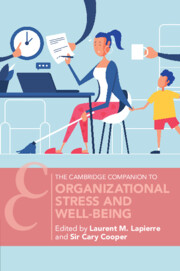Book contents
- Organizational Stress and Well-Being
- Cambridge Companions To Management
- Organizational Stress and Well-Being
- Copyright page
- Contents
- Figures
- Tables
- Contributors
- Introduction
- Part I Historical Evolution and Continued Relevance of the Study of Organizational Stress and Well-Being
- Part II Line Managers
- Part III Major Issues Relating to Stress and Well-Being
- Part IV Workplace Interventions Addressing Stress and Well-Being
- 12 Occupational Stress and Well-Being
- 13 Effective Employee-Targeted Stress and Well-Being Interventions
- Part V Emerging Issues
- Subject Index
- References
13 - Effective Employee-Targeted Stress and Well-Being Interventions
from Part IV - Workplace Interventions Addressing Stress and Well-Being
Published online by Cambridge University Press: 23 February 2023
- Organizational Stress and Well-Being
- Cambridge Companions To Management
- Organizational Stress and Well-Being
- Copyright page
- Contents
- Figures
- Tables
- Contributors
- Introduction
- Part I Historical Evolution and Continued Relevance of the Study of Organizational Stress and Well-Being
- Part II Line Managers
- Part III Major Issues Relating to Stress and Well-Being
- Part IV Workplace Interventions Addressing Stress and Well-Being
- 12 Occupational Stress and Well-Being
- 13 Effective Employee-Targeted Stress and Well-Being Interventions
- Part V Emerging Issues
- Subject Index
- References
Summary
Preventative, adequately funded, high effort occupational stress interventions have better returns on investment. Conversely, the delivery of training to employees who will never use the knowledge, or already have those skills, wastes their time and organizational resources. Instead, training should start with a needs assessment to diagnose what potential problems should be addressed before they inflict lasting harm. Once these objectives are identified, the program should be designed and delivered, preferably by an expert to ensure transfer of training and minimize liability. Job stress interventions include mindfulness, EAPS, psychotherapy (e.g., acceptance and commitment therapy, exposure therapy; to be delivered by a licensed professional), relaxation, mild physical exercise, and coaching, among others. Some are commercially available, and others are freely available online. Participation should be incentivized, but not mandatory, even though poor attendance is an obstacle to program outcomes.
Keywords
- Type
- Chapter
- Information
- Organizational Stress and Well-Being , pp. 418 - 438Publisher: Cambridge University PressPrint publication year: 2023



